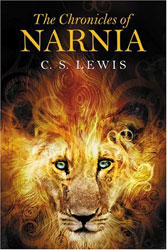Classic Read Aloud Series: The Chronicles of Narnia
Before the current film series, 'The Chronicles of Narnia' was a widely admired fantasy book series by C.S. Lewis. The seven books in the series describe a magical world that has been adored by readers since the 1950s. In addition to the captivating stories, the series also offers a variety of teaching opportunities to help your child better understand both the Narnia series and literature in general.

 |
About the Series
In 1950, C.S. Lewis published The Lion, the Witch and the Wardrobe. The story follows four English siblings, Peter, Susan, Edmund and Lucy Pevensie, who stumble through a magical wardrobe into Narnia, a miraculous world full of unusual creatures, excitement and danger. Once in Narnia, they must help Aslan, a talking lion, defend the world from the White Witch, who has plunged Narnia into perpetual winter. Upon their success, they become kings and queens who reign over a peaceful era.
The Lion, the Witch and the Wardrobe was followed by six more novels, detailing stories taking place before and after the first book. The other novels introduce a variety of other major characters, including Prince Caspian, who requires the Pevensie children's help to save a Narnia that is in grave danger from new evil forces. Other characters from England visit Narnia, such as Eustace Scrubb, who accompanies Prince Caspian in The Voyage of the Dawn Treader. The penultimate book in the series, The Magician's Nephew, describes the creation of Narnia by Aslan and how evil first came to exist there.
Teaching Opportunities
There's no shortage of teaching opportunities to accompany reading The Chronicles of Narnia. First, the series provides an excellent chance to explore literary devices. For example, ask your child how Lewis uses stories within stories, such as the Pevensie children disappearing into Narnia against the backdrop of England during World War II. While years transpire in Narnia, mere moments pass in England. Discuss how structure impacts the story with regards to narrative flow and suspense.
Also, both Narnia and England offer a dynamic and diverse set of characters. Your child can create a journal of the myriad characters, noting their traits, motivations and relationships. As you progress through the series, note how characters are used differently depending on the book. For example, the Pevensie children are major characters in The Lion, the Witch and the Wardrobe, minor characters in The Horse and His Boy and entirely absent in The Silver Chair.
Expanding upon the journal idea, work on a timeline and map with your child. The complexity of the Narnia stories can be difficult for young readers to follow. This is especially true when time moves at different speeds in different worlds and the books do not progress in a linear narrative sequence. Creating a map will help your child understand the diversity of the world Lewis created.
Another teaching opportunity is the exploration of themes. There are many themes in the Narnia series, though the most prominent is the battle between good and evil. Discuss with your child how good and evil are presented in the novel, such as through particular characters or events. You can ask your child how characters have differing motivations and how this affects their actions. In exploring this theme and others, you and your child can discover and rediscover the Narnia books for years to come.
Other Articles You May Be Interested In
-
How to Help Your Child Read Above Their Grade-Level

Reading is important in our daily lives and is a cornerstone in all other academic subjects, including math and science. Do you want your child to not only succeed in reading but to excel beyond their (and possibly your) expectations? There are some things you can do to help your child improve their reading skills and maybe even...
-
5 Creative Ways to Celebrate Read to Your Child Day

February 14th is not only Valentine's Day, it's also Read to Your Child Day, an occasion to celebrate reading with your child. Here are five ideas for how you can observe this special day.
We Found 7 Tutors You Might Be Interested In
Huntington Learning

- What Huntington Learning offers:
- Online and in-center tutoring
- One on one tutoring
- Every Huntington tutor is certified and trained extensively on the most effective teaching methods
K12

- What K12 offers:
- Online tutoring
- Has a strong and effective partnership with public and private schools
- AdvancED-accredited corporation meeting the highest standards of educational management
Kaplan Kids

- What Kaplan Kids offers:
- Online tutoring
- Customized learning plans
- Real-Time Progress Reports track your child's progress
Kumon

- What Kumon offers:
- In-center tutoring
- Individualized programs for your child
- Helps your child develop the skills and study habits needed to improve their academic performance
Sylvan Learning

- What Sylvan Learning offers:
- Online and in-center tutoring
- Sylvan tutors are certified teachers who provide personalized instruction
- Regular assessment and progress reports
Tutor Doctor

- What Tutor Doctor offers:
- In-Home tutoring
- One on one attention by the tutor
- Develops personlized programs by working with your child's existing homework
TutorVista

- What TutorVista offers:
- Online tutoring
- Student works one-on-one with a professional tutor
- Using the virtual whiteboard workspace to share problems, solutions and explanations